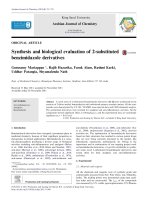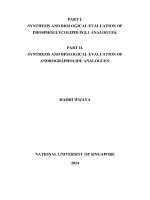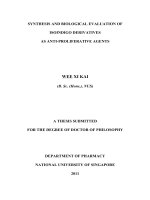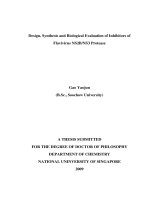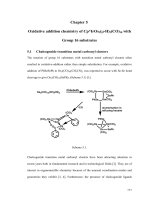Synthesis and biological evaluation of isoindigo derivatives as anti proliferative agents
Bạn đang xem bản rút gọn của tài liệu. Xem và tải ngay bản đầy đủ của tài liệu tại đây (21.92 MB, 262 trang )
SYNTHESIS AND BIOLOGICAL EVALUATION OF
ISOINDIGO DERIVATIVES
AS ANTI-PROLIFERATIVE AGENTS
WEE XI KAI
(B. Sc. (Hons.), NUS)
A THESIS SUBMITTED
FOR THE DEGREE OF DOCTOR OF PHILOSOPHY
DEPARTMENT OF PHARMACY
NATIONAL UNIVERSITY OF SINGAPORE
2011
ii
Acknowledgements
First and foremost, I would like to dedicate my heartfelt gratitude to my supervisor
Associate Professor Go Mei Lin for her immeasurable guidance and encouragement
throughout the entire course of my research work. I am very grateful to her for accepting me
into UROPS in 2005 when I was a life science undergraduate. My passion for medicinal
chemistry has grown enormously for the past 6 years under her mentorship. This thesis would
not be possible without her invaluable insights and supervision in this research project.
Secondly, I would also like to thank my postdocs Dr Liu Jian Chao, Dr Suresh Kumar
Gorla and Dr Yang Tianming for their enlightening discussions and scientific advice rendered.
Special thanks go to my FYP mentors Dr Kong Kah Hoe and senior Dr Lee Chong Yew for
their guidance during my honours year project.
I am also grateful to my fellow seniors and lab-mates of the past 6 years in the
Medicinal Chemistry Lab in the pharmacy department: Dr Liu Xiaoling, Dr Zhang Wei, Dr
Leow Jolene, Dr Sim Hong May, Dr Nguyen Thi Hanh Thuy, Mr Yeo Wee Kiang,, Mr Pondy
Murgappan Ramanujulu, Ms Tan Kheng Lin Meg, Ms Xu Jin, Ms Pang Yi Yun and Ms Chen
Xiao. Appreciation also goes to Dr Leow Pay Chin, Dr Cheong Siew Lee and Dr Yang Hong
from pharmacy who has given me valuable advice. It is also my pleasure to thank research
assistants Ms Tee Hui Wern and Ms Audrey Chan who has assisted significantly in my earlier
work. Acknowledgements are also made to lab officers Ms Oh Tang Booy, Ms Ng Sek Eng,
Ms Wang Xiaoning, Ms I-Fon Bambang, Ms Lye Pey Pey and Mr Johannes Murti Jaya who
has facilitated a great deal throughout my project.
My appreciation goes to my final year student Mr Clement Ong Jun Wen who has
contributed significantly to my isoindigo project and all past year undergraduate students who
has helped me in one way or another.
iii
I am also eternally grateful to the research scholarship and President Graduate
Fellowship (PGF) award received from National University of Singapore for my postgraduate
study.
Last but not least, I would like to thank my parents, family and friends for their
constant support, understanding and concern throughout the course of my graduate studies.
iv
Conferences
1) Xi-Kai Wee and Mei-Lin Go, Isoindigo Derivatives as Potent Anticancer Agents. 1
st
Singapore – Hong Kong Bilateral Graduate Student Congress in Chemical Sciences, 28
th
-30
th
May 2009, National University of Singapore, Singapore.
2) Xi-Kai Wee and Mei-Lin Go, Isoindigo Derivatives as Potent Anticancer Agents. Bandung
International Conference on Medicinal Chemistry, 6
th
-8
th
Aug 2009, Institut Teknologi
Bundung, Indonesia. *Best Conference Poster Award*
3) Xi-Kai Wee and Mei-Lin Go, Lead Optimization of Meisoindigo as Anti-proliferative
agents. 25
th
-28
th
Jan 2010, Biopolis, Singapore
4) Xi-Kai Wee and Mei-Lin Go, A Lead Optimization Study of Meisoindigo. The 7
th
International Symposium for Chinese Medicinal Chemist. 1
st
-5
th
Feb 2010. Kaohsiung,
Taiwan.
5) Xi-Kai Wee, Clement Jun-Wen Ong and Mei-Lin Go, Lead Optimization Study of
Meisoindigo Against Leukemia. 21
st
International Symposium on Medicinal Chemistry. 5
th
-
9
th
Sep 2010. Brussels, Belgium.
Publications
1. Wee, X. K.; Yeo, W. K.; Zhang, B.; Tan, V. B. C.; Lim, K. M.; Tay, T. E.; Go,
M. L. Synthesis and evaluation of functionalized isoindigos as antiproliferative agents.
Bioorganic & Medicinal Chemistry 2009, 17, 7562-7571.
v
Table of Contents
Acknowledgements……………………………………………………………………………ii
Conferences and Publications iv
Table of contents …………………………………………………………………………… v
Summary………………………………………………………………………………….… xii
List of Tables xiv
List of Figures……… xvii
List of Schemes………………………………………………………………………….… xxi
List of Abbreviations…………………………………………………………………….…xxiii
Chapter 1: Introduction…………………………………………………………………… 1
1.1. Indigoids…………………………………………………………………………… 1
1.2. Structural modifications to improve the aqueous solubility profile of indirubins ……2
1.3. Meisoindigo………………………………………………………………………… 4
1.4. Structural modifications to improve the aqueous solubility profile of isoindigos… 5
1.4.1. The isoindigo scaffold……………………………………………………… 5
1.4.2. Analogs of isoindigo designed to overcome the poor water solubility of the
scaffold 9
1.5. Biological properties of functionalized isoindigos………………………………… 14
1.5.1. Mode of action of meisoindigo…………………………………………………… 14
1.5.2. Mode of action of functionalized isoindigos…………………………………… 15
1.5.3. Isoindigos as ligands of the Arylhydrocarbon Receptor (AhR)………………… …16
1.6. Statement of Purpose…………………………………………………………… ….18
Chapter 2: Functionalized isoindigos as cyclin-dependent kinase (CDK) inhibitors:
Structure-based design and in vitro evaluation. …………………………………… …21
2.1. Introduction………………………………………………….…………………… 21
2.2. Results………………………………………………………… ……………… …22
vi
2.2.1. Docking of isoindigos onto the ATP binding site of CDK2…………………… ….22
2.2.2. Evaluation of CDK inhibitory activity of test compounds by the Immobilized Metal
Ion Affinity-based Fluorescence Polarization (IMAP) assay…………………… 29
2.2.3. Evaluation of selected isoindigos for inhibition of different kinases…………… …30
2.2.4. Re-evaluation of molecular docking results of selected isoindigos by molecular
dynamics (MD)…………………………………………………………… … … 33
2.2.5. Evaluation of growth inhibitory activities of synthesized isoindigos on human chronic
myelogenous leukemia lymphoblast cells (K562) using the microculture tetrazolium
(MTT) assay………………………………………………………………………… 35
2.3. Discussion…………………………………………………………………… …….39
2.4. Summary………………………………………………………………… … … 40
2.5. Experimental methods………………………………………………………… … 41
2.5.1. Docking of isoindigos onto the ATP binding site of CDK2…………………… ….41
2.5.2. Evaluation of CDK inhibitory activity of test compounds by the Immobilized Metal
Ion Affinity-based Fluorescence Polarization (IMAP) assay………………… … 43
2.5.3. Evaluation of selected isoindigos for inhibition of different kinases………… ……44
2.5.4 Molecular Dynamics simulation of the binding of meisoindigo and I30 with CDK2
………………………………………………………………………………… …44
2.5.5. Growth Inhibitory Assay on K562 cells……………………………………… ……44
Chapter 3: Design and Synthesis of Target Compounds…………………………… … 46
3.1. Introduction……………………………………… ………………………… ……46
3.2. Rationale of drug design……………………………………………………… … 46
3.2.1. Series 1……………………………………………………………………… …….46
3.2.2. Series 2………………………………………………………………………… ….47
3.2.3. Series 3………………………………………………………………………… ….50
3.2.4. Series 4………………………………………………………………………… ….52
3.2.5. Series 5………………………………………………………………………… ….53
3.2.6. Series 6………………………………………………………………………… … 54
vii
3.2.7. Series 7.………………………………………………………………………… ….56
3.3. Chemical considerations………………………………………………………… 57
3.3.1. Disconnection approach to the synthesis of functionalized isoindigos….…… ……57
3.3.2. Synthesis of Series 1……………………………… …………………………… …60
3.3.3. Synthesis of Series 2……………………………….………………………… ……62
3.3.4. Synthesis of Series 3……………………………….………………………… …….65
3.3.5. Synthesis of Series 4……………………………………….………………… …….67
3.3.6. Synthesis of Series 5……………………………………….…………………… ….68
3.3.7. Synthesis of Series 6……………………………………….…………………… ….69
3.3.8. Synthesis of Series 7…………………………… ……………………………… …74
3.4. Summary………………………………………….………… ………………… …75
3.5. Experimental methods…………………………………………………………… 75
3.5.1 General Details………………………………………………………………… … 75
3.5.2. Series 1 ………………………………………… ……………………………… …76
3.5.2.1. (E)-[3,3'-biindolinylidene]-2,2'-dione (1-1) 76
3.5.2.2. 1-Methylindoline-2,3-dione (A-2)…………….……………………………… … 77
3.5.2.3. (E)-1-Methyl-[3,3'-biindolinylidene]-2,2'-dione /meisoindigo (1-2) 77
3.5.2.4. (E)-1,1'-dimethyl-[3,3'-biindolinylidene]-2,2'-dione (1-3)……………………… …78
3.5.2.5. [3,3'-biindoline]-2,2'-dione (1-4)………………………………………… … ……78
3.5.3. Series 2 analogues……………………………………………………………… …78
3.5.3.1. General method for the preparation of 1-alkylated isatin intermediates (B-2, B-3, B-4,
B-5, B-6, B-7, B-12, B-13, B-17, B-20)……………………………………… … 78
3.5.3.2. General method for the preparation of 1-alkylated isatin intermediates (B-10, B-14,
B-15, B-18, B-19)………………………… ……… 79
3.5.3.3. N-(4-(2-chloroethyl)phenyl)acetamide (B-11)……………………………… ….….79
3.5.3.4. (2-chloroethoxy)benzene (B-16)…………………………………………… … …80
3.5.3.5. General method for the preparation of 1-alkylated isoindigos (2-2, 2-3, 2-4, 2-5, 2-7,
2-12) by aldol condensation…………………………………………………… …80
viii
3.5.3.6. General method for the preparation of 1-alkylated isoindigos (2-1, 2-6, 2-10, 2-14,
2-15, 2-17, 2-18, 2-19, 2-20, 2-21) by aldol condensation……………… …………80
3.5.3.7. General method for the preparation of 1-alkylated isoindigo via direct alkylation onto
isoindigo (2-9, 2-11, 2-13, 2-16)………………………………… …………… … 81
3.5.3.8. (E)-1-(4-hydroxyphenethyl)-[3,3'-biindolinylidene]-2,2'-dione (2-8) 81
3.5.4. Series 3……………………………………………………….…………… … … 81
3.5.4.1. General method for the preparation of 1-methylated substituted isatins (C-1, C-2, C-3,
C-4, C-5, C-6, C-7, C-9, C-10, C-11)………… ……………………………… 81
3.5.4.2. General method for the preparation of 1-methylated substituted 2-oxindoles (C-8, C-
12)……………………………………………………………………………… …82
3.5.4.3. 6-aminoindolin-2-one (C-25)…………………………….…………………… … 82
3.5.4.4. 6-(dimethylamino)indolin-2-one (C-26)……………… ……… ………… …… 82
3.5.4.5. N-(2-oxoindolin-6-yl)acetamide (C-29)………………………… …… … …… 83
3.5.4.6. N-(2-oxoindolin-6-yl)methanesulfonamide (C-30) 83
3.5.4.7. General method for the preparation of Series 3 compounds (3-1 to 3-7, 3-9 to
3-11) 83
3.5.4.8. General method for the preparation Series 3 compounds (3-8, 3-12)……………… 84
3.5.4.9. General method for the preparation of Series 3 compounds (3-20, 3-24 to
3-30) …………………………………………………………………………………84
3.5.4.10. General method for the preparation of Series 3 compounds (3-13 to 3-19,
3-21 to 3-23)………………………………………………………………… … 84
3.5.5. General method for synthesis of Series 4 compounds (4-1 to 4-5)……….….… 84
3.5.6. Series 5…………….……………………………………………………….…… ….84
3.5.6.1. General method for the preparation of Series 5 compounds (E-1 to E-11)……….…84
3.5.6.2. General method for the preparation of Series 5 compounds (5-1 to 5-11)……… …85
3.5.6.3. General method for the preparation of Series 5 compounds (5-12-5-25)……… 85
3.5.7. Series 6…………………………………………………….……………………… 85
3.5.7.1. General method for the preparation of F-1 to F-4……………………… … … …85
ix
3.5.7.2. General method for the preparation of F-5 and F-6………… ………………… …86
3.5.7.3. General method for the preparation of 4-1 and 4-4. …………… ………… … 86
3.5.7.4. (E)-6'-methoxy-1-(2-morpholinoethyl)-[3,3'-biindolinylidene]-2,2'-dione (6-5)… 86
3.5.7.5. General method for the preparation of 6-2 and 6-3……………………… … ….86
3.5.7.6. 1-(2-bromoethyl)indoline-2,3-dione (F-7)…………………………………… …….87
3.5.7.7. General method for the syntheses of F-8 & F-9………………….…………… … 87
3.5.7.8. General procedure for synthesis of 6-4 and 6-6 from F-8 and F-9……………… …87
3.5.7.9. 3,3-Dibromo-1H-pyrrolo[2,3-b]pyridin-2(3H)-one (F-10) 87
3.5.7.10.1H-pyrrolo[2,3-b]pyridin-2(3H)-one (F-11) 88
3.5.7.11.General method for the preparation of 6-7 and 6-8 88
3.5.8. General method for the preparation of 7-1 & 7-2……………………………… … 88
Chapter 4: Cell-based growth inhibitory activities of functionalized isoindigos and
related compounds in Series A-G……………………………………………………… …89
4.1 Introduction……………………………………………………………… …… …89
4.2. Experimental……………………………………………………………………… 89
4.2.1 Cell lines………………………………………………………………………… …89
4.2.2 Propagation of cells…………………………………………………………… …90
4.2.3 MTT assay for determination of cell viability…………………………………….…90
4.2.4 Statistical analysis……………………………………………………………… ….91
4.3 Results ………………………………………………………………………… … 92
4.3.1 Growth inhibitory activity on human chronic myelogenous leukemic cells K562….92
4.3.1.1. Series 1……………………………………….……….………………………… ….92
4.3.1.2. Series 2……………………………………………….……………………… …… 92
4.3.1.3. Series 3…………………………………………….…………………………… … 95
4.3.1.4. Series 4……………………………………….….…………………………… …….97
4.3.1.5. Series 5………………………………………….……………………………… … 99
x
4.3.1.6. Series 6………………………………………………………….……………… 101
4.3.1.7 Series 7………………………………………………………….……………… …103
4.3.2. Growth inhibitory activity of selected compounds on other cell lines……… ……103
4.4. Discussion……………………………………………………………………… …108
4.5 Summary……………………………………………………………………… ….111
Chapter 5: Investigations into the physicochemical properties and effects on cell cycle &
apoptosis of meisoindigo and selected potent analogs. …………………………… … 112
5.1 Introduction ……………………………………………………………… ………112
5.2 Experimental section………………………………………………………… … 113
5.2.1. Determination of aqueous solubility………………………………………… …113
5.2.2. Assessment of aggregation tendency by dynamic light scattering (DLS)…… … 114
5.2.3. Cell cycle analysis by flow cytometry……………………………………… ……115
5.2.4 Apoptotic cell determination by Annexin V/ propidium iodide (PI) staining… ….115
5.2.5 Statistical analysis……………………………………………………………….….116
5.3 Results………………………………………………………………………… ….116
5.3.1. Aqueous solubilities of test compounds……………………………………… … 116
5.3.2. Formation of colloidal aggregates …………………………………………… … 119
5.3.3. Effects of meisoindigo (1-2), 4-5 and 6-4 on the cell cycle distribution of K562 cells
……………………………………………………………………………… … 122
5.3.4. Effects of meisoindigo (1-2), 4-5 and 6-4 on the induction of apoptosis in K562 cells.
……………………………………………………………………………… … 126
5.4. Discussion……………………………………………………………………… …133
5.5. Summary…………………………………………………………………… … 136
Chapter 6: In vivo evaluation of meisoindigo, 4-5 and 6-4 in mice bearing human
myeloid chronic leukemia cells (K562) xenografts………………………….……… ….138
6.1 Introduction…………………………………………………………… ………….138
6.2 Experimental ………………………………………………………………… … 138
xi
6.2.1 Materials……………………………………………………………………… … 138
6.2.2 In vivo studies………………………………………………………………… … 139
6.2.3 Statistical Analysis………………………………………………………… … 140
6.3 Results………………………………………………………………………… ….140
6.4 Discussion……………………………………………………………… …… …145
6.5. Summary……………………………………………………………………… ….146
Chapter 7: Conclusions and Future Work……………………………………… …….147
Bibilography………………………………………………………………………… ……153
Appendix
Appendix 2-1A: Summary of Kinome Screen Results……………………………… …… 1-
Appendix 2-1B: List of kinases screened in the ScanEdge
Kinome screen………… …… 3-
Appendix 2-2: Written script for docking process………………………………… ………-5-
Appendix 2-3: Molecular Dynamics………………………………………………… …… 8-
Appendix 3-1: Analytical data and details of synthesized compounds……………… … 12-
Appendix 3-2: Determination of purity by HPLC…………………………………… … 73-
Appendix 5-1: Determination of optimum wavelength for the solubility assay……… …-74-
Appendix 5-2: Representative calibration curves for the solubility assay…………… … 75-
Appendix 5-3: Representative figure showing FACS analysis of normal, apoptotic and
necrotic K562 cells after 48 h incubation. ……… …………………………………… …-76-
Appendix 6-1: Changes in tumour size (mm
3
) (28 days) of xenograft-bearing mice treated
with vehicle (Control) and test compounds (meisoindigo, 4-5, 6-4).………… ……… …-77-
xii
Summary
Driven by the lack of literature on the potential of functionalized isoindigos as anti-
proliferative agents, the aim of this thesis was to investigate medicinal chemistry approaches
towards the design and synthesis of functionalized isoindigos with enhanced potency and
pharmaceutically friendly profiles. Six series of compounds comprising of 93 isoindigo
analogues have been synthesized in this project.
Initially, it was hypothesized that a structure-based approach based on the reported
CDK inhibitory activity of meisoindigo would be a meaningful way of designing analogs with
improved anti-proliferative activity. However, an unexpected finding in the early stage of the
project was that meisoindigo failed to inhibit CDK2. A similar result was obtained by an in
silico molecular dynamics study. Hence, a phenotypic approach was adopted for biological
evaluation. The synthesized compounds were evaluated for growth inhibitory activities on a
chronic myelogenous leukemia cell line (K562).
The key features of the potent analogues associated with growth inhibitory properties
are (i) intact exocyclic double bond; (ii) presence of at least one amidic NH group; (iii)
substitution at position 6 /6’ with methoxy group; (iv) a 1-(phenpropyl) or 1-(4-
methoxyphenpropyl) side chain if ring A or B of the scaffold is not substituted and (v) a 1-(4-
methoxyphenethyl) side chain if ring B is substituted with 6’-methoxy. 4-5 (IC
50
= 0.50µM)
which is more than 15 fold more potent that meisoindigo (IC
50
= 7.75µM) was identified as
the most potent analogue from the library. 4-5 has outstanding selectivity profiles which
exceeds that of meisoindigo. However it is hampered by its high lipophilicity (ClogP = 4.8)
and poor aqueous solubility (22 µM).
An important modification undertaken in Series F is the introduction of polar
features that would improve the poor solubility of the scaffold. Compound 6-4 was observed
to have excellent solubility (≥ 400 µM) while achieving significant improvement in
antiproliferative activity (IC
50
3.97 µM).
xiii
In the subsequent mechanistic studies, 4-5 caused G2 arrest and apoptosis of K562
cells at its IC
50
concentration. Meisoindigo on the other hand was not found to cause cell
cycle arrest at its IC
50
concentration but apoptosis was observed. The soluble analogue 6-4
was observed to behave like meisoindigo.
Given significant advances in potency for 4-5 and aqueous solubility for 6-4, the two
compounds were evaluated on nude mice bearing K562 xenografts. The results indicated that
in spite of its potent in vitro activity, 4-5 failed to extend survival times of the xenograft
bearing mice or significantly reduced the tumour volume In contrast, the analog with
improved aqueous solubility 6-4 resulted in significant improvements in both survival times
and tumor size. In line with the objectives of this thesis, structural modifications of
meisoindigo has led to 6-4 with improved in vitro / in vivo activity as well as a more desirable
drug like profile.
(457 words)
xiv
List of Tables
Table 1-1: Aqueous solubilities of indirubin and isoindigo (pH 7.4) determined by ACD/Labs
Version 12……………………………………………………………………………… …….7
Table 1-2: Aqueous solubilities of isoindigo and azaisoindigo (pH7.4) determined by
ACD/Labs Version 12…………………………………………………………… …………12
Table 2-1: Docking scores obtained from Autodock4 for 1-alkyl-isoindigo series……… 24
Table 2-2: % Inhibition of 96 kinases by meisoindigo (1-2) and 2-13 at 10 µM. ……… ….30
Table 2-3: Hydrogen bonds and binding free energies of meisoindigo (1-2) and indirubin 3’-
oxime (I3O) bounded CDK2 obtained from MD simulations. ………………………………33
Table 2-4: Anti-proliferative data from MTT assay of K562…………………………… …35
Table 2-5: Settings for the (A) grid parameter file and (B) docking parameter file. …… …41
Table 3-1: Series 1 compounds (1-1 to 1-4)…………………….……… …………… … 46
Table 3-2: Series 2 compounds (2-1 to 2-21) : Modifications at position 1…….……….… 47
Table 3-3: Series 3 compounds – Mono-substitution on ring A or B………….………… …50
Table 3-4: Series 4 compounds (4-1 to 4-5): 1-substituted analogues of 3-20…….…….… 51
Table 3-5. Series 5 compounds (5-1 to 5-26) : Analogues of 4-5………….……………… 53
Table 3-6. Series 6 compounds (6-1 to 6-8): Analogues with improved water solubility… 55
Table 3-7. Series 7.compounds (7-1 to 7-4) : Functionalized Indirubins……….……… … 56
Table 4-1: IC
50 K562
and Clog P values of Series 2 compounds……………….……… …… 92
Table 4-2 IC
50
K562
values of compounds 3-1 to 3-26…………… …………………… … 95
xv
Table 4-3 IC
50
K562
values of compounds 4-1 to 4-5………… ………………………… …96
Table 4-4 IC
50
K562
values of compounds 5-1 to 5-20…………………………………….… 99
Table 4-5: IC
50
K562
values of compounds 6-1 to 6-8………………… ……………………100
Table 4-6: IC
50
K562
values of compounds 7-1-7-4……………………………………… …102
Table 4-7: IC
50
values of compounds listed in Figure 4-5 on K562, HuH7, RCC786 and HCT
116 cells………………………………………………………………………… …105
Table 4-8: IC
50
values of selected compounds on NB4 and IMR-90 cells………… ……106
Table 5.1 Solubility of Test Compounds determined at room temperature (28°C) in Universal
buffer (pH7.4) containing 1% v/v DMSO. …………………………………………… ….117
Table 5-2. Dynamic light scattering (kilocount per sec) and particle size measurements of test
compounds. ………………………………………………………………………….… ….120
Table 5-3. Effect of Meisoindigo on the different phases of the cell cycle of K562
cells… 122
Table 5-4. Effect of 6-4 on the different phases of the cell cycle of K562 cells……… 123
Table 5-5. Effect of 4-5 on the different phases of the cell cycle of K562 cells…….… 125
Table 5-6: Distribution of normal, apoptotic and necrotic K562 cells treated with varying
concentrations of 1-2 (24 h) …………………………………………………… …… … 127
.
Table 5-7: Distribution of normal, apoptotic and necrotic K562 cells treated with varying
concentrations of 6-4 (24 h) …………… ……………….…………………………… ….129
Table 5-8: Distribution of normal, apoptotic and necrotic K562 cells treated with varying
concentrations of 4-5 (24 h) …………………………………………………………… ….130
xvi
Table 5-9: Distribution of normal, apoptotic and necrotic K562 cells treated with
mesioindigo (1-2), 6-4 and 4-5 at 5 µM and 10 µM after an incubation period of 48 h. … 132
Table 6-1: Kaplan-Meier analysis for comparison between treatment groups in xenograft-
bearing mice. ……………………………………………………………………… … ….140
Table 6-2: Log rank test (pairwise comparison) p-values of different treatment groups… 140
xvii
List of Figures
Figure 1-1: Structures of Indigo, Indirubin and Isoindigo……………………………… … 1
Figure 1-2: Structures of selected indirubins with kinase inhibitory properties………… … 2
Figure 1-3: Intramolecular hydrogen bonding in indirubin drawn using MOE software… …3
Figure 1-4: Selected indirubins with potent CDK2 inhibition…………………………… ….4
Figure 1-5: Structure of Meisoindigo (1-2)……………………………………………… … 5
Figure 1-6: (A) C
2h
rotational symmetry in isoindigo, (B) Rotational symmetry in S1 and S2,
(C) Absence of rotationally symmetry in S3 and S4……………………………………… …6
Figure 1-7: Structure of 1,1’-dibutylisoindigo drawn using MOE-2008 software……… … 7
Figure 1-8: Planar and skewed configurations of the isoindigo………………………… … 8
Figure 1-9: Geometric isomers of isoindigo (A) E isomer: distance between H
4
and H
4’
= 5.88
Å. (B) Z isomer. Distance between H
4
and H
4’
= 0.76 Å. …………………………….… ….8
Figure 1-10: Structure of Natura®………………………………………………….…… … 9
Figure 1-11: Compound 1 from Sassatelli and co-workers……………………………… …11
Figure 1-12: Compounds 2, 3 & 4 from Sassatelli and co-workers………….……………….11
Figure 1-13: Compounds 5 & 6 from Bouchikhi and co-workers………….…………… ….12
Figure 1-14: Compounds 7, 8, 9 & 10 from Bouchikhi and co-workers……….……… ….13
Figure 1-15: Compounds from Wang and co-workers………………………………… … 14
Figure 2-1: Workflow for structure-based drug design………………………………… … 21
xviii
Figure 2-2: Interaction of 5BI with the “hinge” amino acid residues gk+1 and gk+3 at the
ATP binding site of CDK2 as observed in 2BHE, visualized on MOE software…….…… 22
Figure 2-3: Docked pose of BIO seen on Autodock4……………………………….…… …23
Figure 2-4: Docked pose of meisoindigo (1-2) seen on Autodock4…………… ……… ….25
Figure 2-5: Docked conformation of 2-3 seen on Autodock4………………………… ……26
Figure 2-6: Docked conformation of 2-13 seen on Autodock4………………………… … 26
Figure 2-7: Docked pose of 2-11 seen on Autodock4…………………………………… …27
Figure 2-8: Working principle of the IMAP Assay…………………………………… ……28
Figure 2-9: % Inhibition of CDK2 at 10 µM of test compounds as evaluated by the IMAP
assay. ……………………………………………………………………………………… 29
Figure 2-10: Location of kinases inhibited by 40-52% by 2-13 (10 µM) on the Kinome tree.
……………………………………………………………………….…………………… 31
Figure 2-11: RMSD fluctuations of CDK2/CyclinA protein and its respective ligands: (A)
Meisoindigo (1-2), (B) Indirubin-3’-oxime (I3O). 32
Figure 2-12: Viability curve of meisoindigo (1-2). …………………………………… … 37
Figure 2-13: Viability curve of 2-13. …………………………………………………… ….37
Figure 3-1: Energy minimized structures of meisoindigo (1-2) and 1- substituted analogs
drawn on MOE. ……………………………………….………………………………… ….48
Figure 3-2: Mechanism for base catalyzed N-alkylation of isatin……….……………… ….57
Figure 3-3: Mechanism for acid catalyzed Aldol condensation………………………… ….58
Figure 3-4: Mechanism for N-methylation of 2-oxindole…………………………… …… 59
xix
Figure 3-5: Formation of quaternary aziridinium cations………………………….…… … 68
Figure 3-6: Stabilities of Intermediates F-1-F-4 observed at room temperature, in an
atmosphere of argon……………………………….……………………………………… 69
Figure 3-7: Proposed mechanism for the formation of F-10……………………………… 72
Figure 3-8: Mechanism of based-catalyzed hydrolysis and aldol condensation of 3-
acetoxyindole to give indirubins 7-1 and 7-2…………………………………………… ….73
Figure 4-1: Growth inhibitory activity of Series A compounds……………………… …….91
Figure 4-2: Dose response curve of 4-5 on K562 MTT assay. Error bars indicates standard
deviation………………………………………………………………………………… ….97
Figure 4-3: Dose response curve of 6-4 on K562 MTT assay. Error bars indicates standard
deviation………………………………………………………………………… …… ….101
Figure 4-4: Structures and IC
50
K562 of compounds shortlisted for further investigations.
………………………………………………………………………………………… … 103
Figure 4-5: Summary of structural features of functionalized isoindigos that are critical for
growth inhibitory activity on K562 cells……………………………………………… … 109
Figure 5-1: List of structures for the determination of solubility……………………… ….116
Figure 5-2: Representative figure showing the DNA content analysis of K562 cells after 24 h
incubation with vehicle (media + 0.4% v/v DMSO) and meisoindigo (1-2) at stated
concentrations………………………………………………………………………… … 122
Figure 5-3: Representative figure showing the DNA content analysis of K562 cells after 24 h
incubation with vehicle (media + 0.4% v/v DMSO) and 6-4 at stated concentrations. … 124
xx
Figure 5-4: Representative figure showing the DNA content analysis of K562 cells after 24 h
incubation with vehicle (media + 0.4% v/v DMSO) and 4-5 at stated concentrations. ……125
Figure 5-5: Double staining of cells by Annexin V and PI and their relationship to normal,
apoptotic and necrotic cells. ………… ………………………………………… …….….126
Figure 5-6: Representative figure showing FACS analysis of normal, apoptotic and necrotic
K562 cells after 24 h incubation with vehicle (media + 0.4% v/v DMSO) and Meisoindigo
(A2) at stated concentrations. ………………………………………………………… … 128
Figure 5-7: Representative figure showing FACS analysis of normal, apoptotic and necrotic
K562 cells after 24 h incubation with vehicle (media + 0.4% v/v DMSO) and 6-4 at stated
concentrations. …………………………………………………………………… ……….129
Figure 5-8: Representative figure showing FACS analysis of normal, apoptotic and necrotic
K562 cells after 24 h incubation with vehicle (media + 0.4% v/v DMSO) and 4-5 at stated
concentrations. ……………………………………………………………………… …….131
Figure 6-1: In vitro IC
50
K562
and solubilities of meisoindigo, 4-5 and 6-4…… … … ….137
Figure 6-2: Survival plots of Balb/c nude mice bearing K562 xenografts : Control (vehicle
only) animals, animals dosed with 10 µM meisoindigo, 10 µM 4-5 or 10 µM 6-4. ….… 141
Figure 6-3: Changes in body weight (grams) of xenograft-bearing mice treated with vehicle
(Control) and test compounds (meisoindigo, 4-5, 6-4). ………………………………….…142
Figure 6-4: Changes in tumour size (mm
3
) of xenograft-bearing mice treated with vehicle
(Control) and test compounds (meisoindigo, 4-5, 6-4). ………………………………….…143
Figure 7-1: Summary of structural features of functionalized isoindigos that are critical for
growth inhibitory activity on K562 cells……………………………………………… … 148
xxi
List of Schemes
Scheme 3-1: Disconnection approaches to the syntheses of functionalized isoindigos…… 57
Scheme 3-2. Synthesis by Route 1……………………………………………………… ….57
Scheme 3-3: Synthesis by Route 2……………………………………………………… ….59
Scheme 3-4: Synthesis of 1-2……………………… ………………………………… … 60
Scheme 3-5: Synthesis of 1-3 and 1-4………………………… ……………………… ….60
Scheme 3-6: Synthesis of 2-20 and 2-21…………………………… ……………… …….61
Scheme 3-7: Synthesis by Route 3……………………………………………………… ….62
Scheme 3-8: Synthesis of 2-8……………………………………… ………………… … 62
Scheme 3-9: Synthesis of 2-11………………………………… ……………………… …63
Scheme 3-10: Synthesis of 2-16…………………………………… ……………… … 63
Scheme 3-11: Synthesis of 3-1 to 3-7, 3-9 to 3-11, 3-20, 3-24 to 3-30………………………64
Scheme 3-12: Synthesis of 3-8, 3-12 to 3-19, 3-21 to 3-23……………….………………….64
Scheme 3-13: Synthesis of C-25, C-26, 3-25, 3-29 to 3-30……………….…… ………… 66
Scheme 3-14: Synthesis of 4-1 to 4-5…………………………………………… ………….66
Scheme 3-15: Synthesis of 5-1 to 5-25……………… ….…………… 67
Scheme 3-16: Synthesis of 6-1 to 6-4 (Route 3) ……………………………….… ……….68
Scheme 3-17: Synthesis of 6-1 & 6-4 (Route 1) …………………………………….……….70
xxii
Scheme 3-18: Synthesis of 6-4 & 6-6 (via F-7) …………….…………………… … ……71
Scheme 3-19: Synthesis of 6-7 & 6-8………………………………… ………… ……… 72
xxiii
Abbreviations
1
H NMR Proton nuclear magnetic resonance spectrum
13
C NMR Carbon-13 nuclear magnetic resonance spectrum
AcCl Acetyl chloride
ACN Acetonitrile
AcOH Acetic acid
AhR Aryl hydrocarbon receptor
APCI Atomic pressure chemical ionization
ATP Adenosine triphosphate
BIO 6-Bromo-indirubin-3’-oxime
BSA Bovine serum albumin
ca circa (Latin, means “approximately”)
CDK Cyclin-dependent kinase
ClogP Calculated Log partition coefficient (lipophilicity)
CML Chronic myelogenous leukemia
DCM Dichloromethane
DMEM Dulbecco’s modified Eagle’s medium
DMF N, N-Dimethylformamide
DMSO Dimethylsulfoxide
EA Ethyl acetate
EMEM Eagle’s Minimum Essential Medium
eqv equivalent
GSK3β Glycogen synthase kinase 3β
H-bond Hydrogen bond
HCT116 a human carcinoma cell line
Hex n-Hexane
xxiv
HL-60 a human promyelocytic leukemia cell line
HPLC High performance liquid chromatography
HuH7 a human hepatocarcinoma cell line
I3O Indirubin-3’-oxime
IMAP Immobilized Metal Ion Affinity-based Fluorescence Polarization
IMDM Iscove’s modified Dulbecco’s medium
IMR-90 a normal human diploid embryonic lung fibroblast cell line
K562 a human chronic myelogenous leukemia cell line
MD Molecular dynamics
MOE Molecular Operating Environment software, version 2008.10
MS Mass spectroscopy
MTT 3-(4,5-Dimethylthiazol-2-yl)-2,5-diphenyltetrazolium bromide
MW Microwave assisted reactions
PBPB Pyridinium bromide perbromide
PBS Phosphate buffered saline
PDB Protein Data Bank
PI Propidium iodide
PPTS pyridinium p-toluenesulfonate
RCC-786 a human renal carcinoma cell line
RMSD Root mean square deviation
RPMI-1640 Roswell park memorial institute medium no 1640.
RT Room temperature and conditions
SAR Structure-activity relationship
SEM Standard error of mean
TEA Triethylamine
THP 2-tetrahydropyran
1
Chapter 1: Introduction
1.1. Indigoids
Indigoids are a class of compounds with the bisindole framework. There are three
isomeric bisindoles – indigo, indirubin and isoindigo which are of pharmaceutical and
chemical relevance (Figure 1-1).
N
H
H
N
O
O
N
H
NH
O
O
N
H
H
N
O
O
Indigo
Indirubin Isoindigo
Figure 1-1: Structures of Indigo, Indirubin and Isoindigo
Indigo and its di-bromo derivatives are unique dyes that have been used since
antiquity. They are extracted from plants of various genus such as Indigofera and snails
(“blue snails”) of the family Muricidae. In contrast to indigo, indirubin is not used as a textile
dye, in part due to its propensity to convert to indigo during processing.
1
It has, however, been
found to be a pharmacologically active scaffold associated with anti-cancer activity. Several
functionalized indirubins have been investigated for their effects on key pathways involved in
tumorigenesis.
2
The serendipitous discovery of the anticancer properties of indirubin is well
documented in the literature.
2-4
Briefly, it is the outcome of a detailed investigation initiated
by the Chinese Academy of Medical Sciences on the efficacy of a traditional Chinese herbal
prescription, Danggui LongHui Wanfor chronic myelogenous leukemia
(CML). Analysis of the complex herbal mixture narrowed activity to one ingredient – a blue
powder (Qing Dai, indigo naturalis) which contained a large amount of indigo. Unusually,
anti-leukemic activity was not due to indigo but its isomer indirubin (“red indigo”) which is a
minor constituent of the mixture. Indirubin and its derivatives were subsequently found to be
potent inhibitors of cyclin-dependent kinases and to block cell proliferation by arresting the
cell cycle.
2
Notably, indirubin derivatives such as 5-chloroindirubin, indirubin-5-sulfonate

